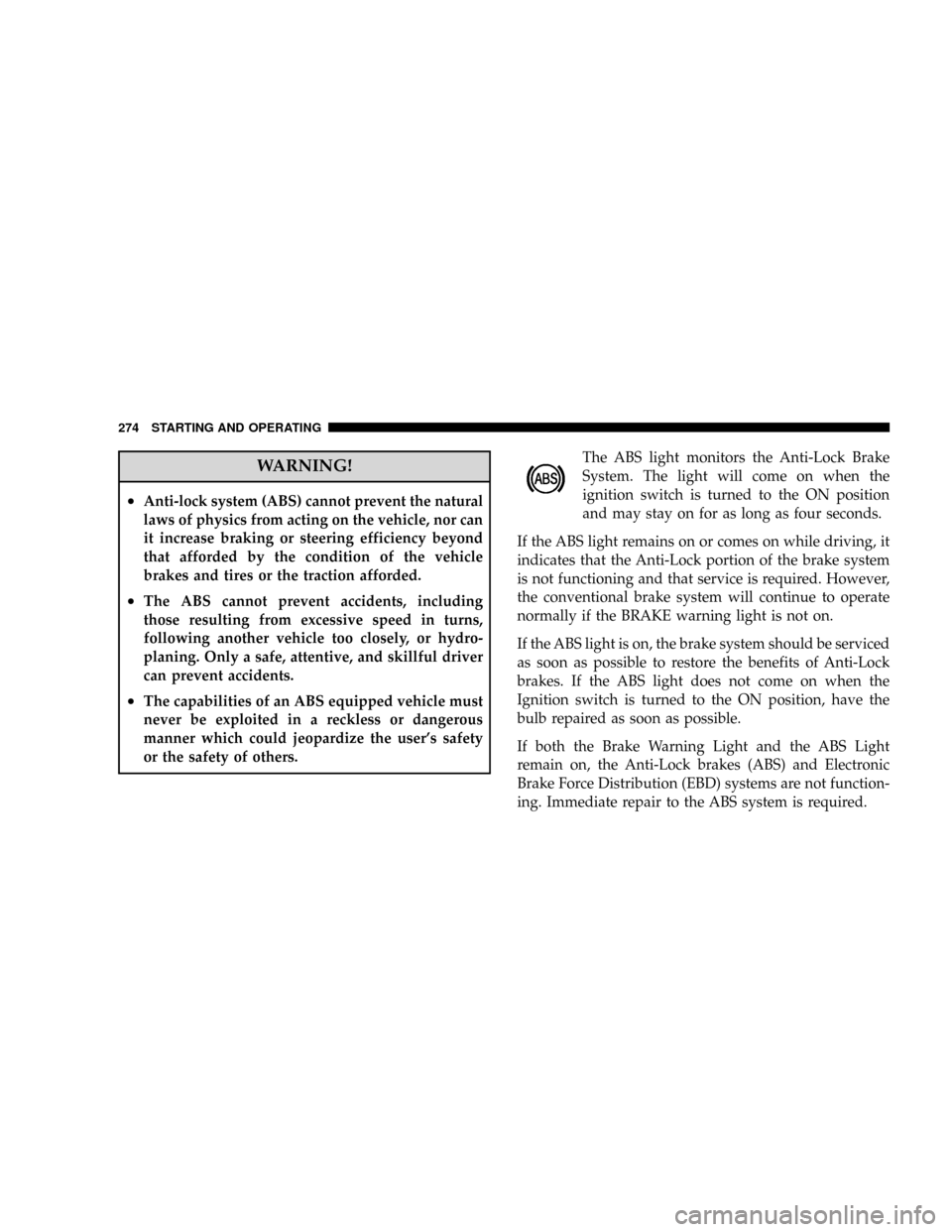Page 275 of 440

WARNING!
²Anti-lock system (ABS) cannot prevent the natural
laws of physics from acting on the vehicle, nor can
it increase braking or steering efficiency beyond
that afforded by the condition of the vehicle
brakes and tires or the traction afforded.
²The ABS cannot prevent accidents, including
those resulting from excessive speed in turns,
following another vehicle too closely, or hydro-
planing. Only a safe, attentive, and skillful driver
can prevent accidents.
²The capabilities of an ABS equipped vehicle must
never be exploited in a reckless or dangerous
manner which could jeopardize the user's safety
or the safety of others.The ABS light monitors the Anti-Lock Brake
System. The light will come on when the
ignition switch is turned to the ON position
and may stay on for as long as four seconds.
If the ABS light remains on or comes on while driving, it
indicates that the Anti-Lock portion of the brake system
is not functioning and that service is required. However,
the conventional brake system will continue to operate
normally if the BRAKE warning light is not on.
If the ABS light is on, the brake system should be serviced
as soon as possible to restore the benefits of Anti-Lock
brakes. If the ABS light does not come on when the
Ignition switch is turned to the ON position, have the
bulb repaired as soon as possible.
If both the Brake Warning Light and the ABS Light
remain on, the Anti-Lock brakes (ABS) and Electronic
Brake Force Distribution (EBD) systems are not function-
ing. Immediate repair to the ABS system is required.
274 STARTING AND OPERATING
Page 341 of 440

NFront Suspension Ball Joints..............357
NBody Lubrication.....................358
NWindshield Wiper Blades................358
NWindshield Washer Reservoir.............359
NExhaust System......................359
NCooling System.......................360
NHoses And Vacuum/Vapor Harnesses.......365
NFuel System Connections................365
NBrake System........................366
NAutomatic Transaxle (CVT)..............368
NManual Transaxle.....................369
NRear Drive Assembly (RDA )± AWD/4WD Models
Only..............................370NPower Transfer Unit (PTU) ± AWD/4WD Models
Only..............................371
NAppearance Care And Protection From
Corrosion...........................371
mFuses/Integrated Power Module (IPM).......376
mVehicle Storage........................380
mReplacement Bulbs......................380
mBulb Replacement......................381
NHeadlamps..........................381
NFog Lights..........................383
NTail Lights, Rear Turn Signals And Backup Lights
Ð Replacement.......................384
NLicense Lights........................386
NCenter High-Mounted Stoplight...........387
340 MAINTAINING YOUR VEHICLE
Page 346 of 440

Your vehicle has a simple ignition key actuated test,
which you can use prior to going to the test station. To
check if your vehicle's OBD system is ready, you must do
the following:
1. Insert your ignition key into the ignition switch.
2. Turn the ignition to the ON position, but do not crank
or start the engine.
3. If you crank or start the engine, you will have to start
this test over.
4. As soon as you turn your key to the ON position, you
will see your MIL symbol come on as part of a normal
bulb check.
5. Approximately 15 seconds later, one of two things will
happen:
a. The MIL will flash for about 10 seconds and then
return to being fully illuminated until you turn off theignition key or start the engine. This means that your
vehicle's OBD system isnot readyand you shouldnot
proceed to the I/M station.
b. The MIL will not flash at all and will remain fully
illuminated until you turn off the ignition key or start
the engine. This means that your vehicle's OBD system
isreadyand you can proceed to the I/M station.
If your OBD system isnot ready,you should see your
authorized dealer or repair facility. If your vehicle was
recently serviced or had a battery failure or replacement,
you may need to do nothing more than drive your
vehicle as you normally would in order for your OBD
system to update. A recheck with the above test routine
may then indicate that the system is now ready.
Regardless of whether your vehicle's OBD system is
ready or not ready, if the MIL symbol is illuminated
during normal vehicle operation, you should have your
MAINTAINING YOUR VEHICLE 345
7
Page 381 of 440

VEHICLE STORAGE
If you will not be using your vehicle for more than 21
days you may want to take steps to preserve your battery.
You may:
²Disengage the mini fuse in the Power Distribution
Center labeled IOD (Ignition Off-Draw).
²Or, disconnect the negative cable from the battery.
REPLACEMENT BULBS
All the inside bulbs are brass or glass wedge base.
Aluminum base bulbs are not approved and should not
be used for replacement.
LIGHT BULBS Ð Interior Bulb Number
Front Header Lamp......................T578
Center Dome Lamp......................T578
Rear Cargo/Flashlight.................8±A35LFLIGHTS BULBS Ð Outside Bulb No.
Low Beam/High Beam Headlight............ H13
Front Park/Turn Signal/Side Marker Light. . 3157NAK
Front Fog Light.........................9145
Center High Mounted Stop Light (CHMSL). . LED As-
sembly
Rear Tail/Stop..........................3157
Rear Turn Signal......................3157AK
Backup Light.....................W16W (921)
License Light.......................... W5W
380 MAINTAINING YOUR VEHICLE
Page 382 of 440
BULB REPLACEMENT
Headlamps
²
Raise the hood and locate connector behind the head-
lamp.
Locating Headlamp Connector
Releasing Red Lock Tab
MAINTAINING YOUR VEHICLE 381
7
Page 383 of 440
²Reach into engine compartment and pull red lock out
at connector.
²Twist the bulb to the left and pull outward from
assembly.
Remove green connector from back of bulb by pulling
straight back
Twisting Bulb From Socket
382 MAINTAINING YOUR VEHICLE
Page 384 of 440
NOTE:These are halogen bulbs. Take care not to touch
the bulb with your fingers. Body oils from your fingers
could cause excessive heat buildup which reduces bulb
life.Fog Lights
See your authorized dealer for replacement.
Removing Halogen Bulb From Assembly
MAINTAINING YOUR VEHICLE 383
7
Page 386 of 440
3. Twist and remove socket from lamp.
Pulling Lamp From BodyRemoving Socket and Bulb
MAINTAINING YOUR VEHICLE 385
7